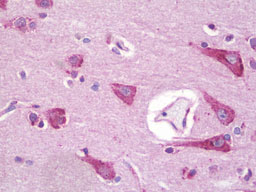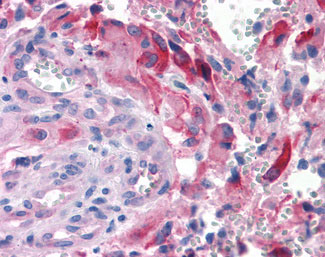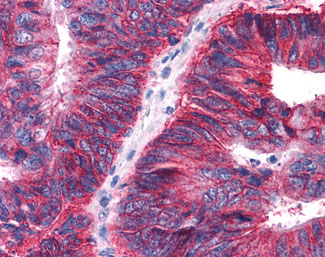APLNR/ Apelin Receptor / APJ Antibody (Extracellular Domain)
Rabbit Polyclonal Antibody
- SPECIFICATION
- CITATIONS
- PROTOCOLS
- BACKGROUND

Application
| IHC-P |
|---|---|
| Primary Accession | P35414 |
| Reactivity | Human, Monkey |
| Host | Rabbit |
| Clonality | Polyclonal |
| Calculated MW | 43kDa |
| Dilution | IHC-P (10-20 µg/ml) |
| Gene ID | 187 |
|---|---|
| Other Names | Apelin receptor, Angiotensin receptor-like 1, G-protein coupled receptor APJ, G-protein coupled receptor HG11, APLNR, AGTRL1, APJ |
| Target/Specificity | Human Apelin Receptor. BLAST analysis of the peptide immunogen showed no homology with other human proteins. |
| Reconstitution & Storage | Long term: -70°C; Short term: +4°C |
| Precautions | APLNR/ Apelin Receptor / APJ Antibody (Extracellular Domain) is for research use only and not for use in diagnostic or therapeutic procedures. |
| Name | APLNR (HGNC:339) |
|---|---|
| Synonyms | AGTRL1, APJ |
| Function | G protein-coupled receptor for peptide hormones apelin (APLN) and apelin receptor early endogenous ligand (APELA/ELA), that plays a role in the regulation of normal cardiovascular function and fluid homeostasis (PubMed:11090199, PubMed:22810587, PubMed:25639753, PubMed:28137936, PubMed:35817871, PubMed:38428423). When acting as apelin receptor, activates both G(i) protein pathway that inhibits adenylate cyclase activity, and the beta-arrestin pathway that promotes internalization of the receptor (PubMed:11090199, PubMed:25639753, PubMed:28137936, PubMed:35817871, PubMed:38428423). APLNR/APJ also functions as mechanoreceptor that is activated by pathological stimuli in a G-protein-independent fashion to induce beta-arrestin signaling, hence eliciting cardiac hypertrophy (PubMed:22810587, PubMed:38428423). However, the presence of apelin ligand blunts cardiac hypertrophic induction from APLNR/APJ on response to pathological stimuli (PubMed:22810587, PubMed:38428423). Plays a key role in early development such as gastrulation, blood vessels formation and heart morphogenesis by acting as a APELA receptor (By similarity). May promote angioblast migration toward the embryonic midline, i.e. the position of the future vessel formation, during vasculogenesis (By similarity). Promotes sinus venosus (SV)-derived endothelial cells migration into the developing heart to promote coronary blood vessel development (By similarity). Also plays a role in various processes in adults such as regulation of blood vessel formation, blood pressure, heart contractility and heart failure (PubMed:25639753, PubMed:28137936). |
| Cellular Location | Cell membrane. Note=After exposure to apelin (APLN), internalized from the cell surface into an endosomal recycling compartment, from where it is recycled to the cell membrane (By similarity). After exposure to apelin receptor early endogenous ligand (APELA), internalized from the cell surface into an endosomal recycling compartment, from where it is recycled to the cell membrane (PubMed:25639753). {ECO:0000250|UniProtKB:Q9JHG3, ECO:0000269|PubMed:25639753} |
| Tissue Location | Expressed in heart, brain, kidney, stomach, spleen, thymus, lung, ovary, small intestine and colon, adipose tissues and pancreas (PubMed:25639753, PubMed:8294032). Expressed in glial cells, astrocytes and neuronal subpopulations (PubMed:8294032). Expressed in embryonic (ESCs) and induced (iPSCs) pluripotent stem cells (PubMed:25639753). |
| Volume | 50 µl |

Thousands of laboratories across the world have published research that depended on the performance of antibodies from Abcepta to advance their research. Check out links to articles that cite our products in major peer-reviewed journals, organized by research category.
info@abcepta.com, and receive a free "I Love Antibodies" mug.
Provided below are standard protocols that you may find useful for product applications.
Background
Receptor for apelin coupled to G proteins that inhibit adenylate cyclase activity and plays a role in various processes in adults such as regulation of blood pressure, heart contractility, and heart failure. Also plays a key role in early development such as gastrulation and heart morphogenesis by acting as a receptor for APELA hormone. Alternative coreceptor with CD4 for HIV-1 infection; may be involved in the development of AIDS dementia.
References
O'Dowd B.F.,et al.Gene 136:355-360(1993).
Eggerickx D.,et al.Submitted (JUN-1995) to the EMBL/GenBank/DDBJ databases.
If you have used an Abcepta product and would like to share how it has performed, please click on the "Submit Review" button and provide the requested information. Our staff will examine and post your review and contact you if needed.
If you have any additional inquiries please email technical services at tech@abcepta.com.













 Foundational characteristics of cancer include proliferation, angiogenesis, migration, evasion of apoptosis, and cellular immortality. Find key markers for these cellular processes and antibodies to detect them.
Foundational characteristics of cancer include proliferation, angiogenesis, migration, evasion of apoptosis, and cellular immortality. Find key markers for these cellular processes and antibodies to detect them. The SUMOplot™ Analysis Program predicts and scores sumoylation sites in your protein. SUMOylation is a post-translational modification involved in various cellular processes, such as nuclear-cytosolic transport, transcriptional regulation, apoptosis, protein stability, response to stress, and progression through the cell cycle.
The SUMOplot™ Analysis Program predicts and scores sumoylation sites in your protein. SUMOylation is a post-translational modification involved in various cellular processes, such as nuclear-cytosolic transport, transcriptional regulation, apoptosis, protein stability, response to stress, and progression through the cell cycle. The Autophagy Receptor Motif Plotter predicts and scores autophagy receptor binding sites in your protein. Identifying proteins connected to this pathway is critical to understanding the role of autophagy in physiological as well as pathological processes such as development, differentiation, neurodegenerative diseases, stress, infection, and cancer.
The Autophagy Receptor Motif Plotter predicts and scores autophagy receptor binding sites in your protein. Identifying proteins connected to this pathway is critical to understanding the role of autophagy in physiological as well as pathological processes such as development, differentiation, neurodegenerative diseases, stress, infection, and cancer.




